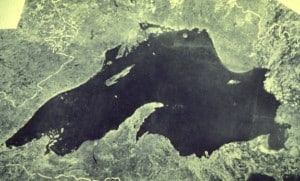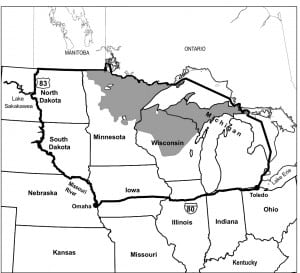Select a Location
Michigan at a glance
Gray wolves once existed throughout Michigan. However, removal began shortly after European settlement. Wolves were removed primarily through poisoning between 1838 and 1960. Within a few years after their protection under the Endangered Species Act, wolves began immigrating from Wisconsin, and in 1991 a wolf pack was confirmed to be reproducing in Michigan.
In December 2014 they were relisted on the Endangered Species Act in Michigan, Wisconsin and Minnesota. For more on this topic, see this story on the Michigan Department of Natural Resources website.
The wolf’s main prey there are deer, elk, moose and beaver. Wolf range is approximately 25 percent of the map shown, including 90 percent of the Upper Peninsula and 100 percent on Isle Royale.
Isle Royale is an island in northwestern Lake Superior. This island is 44.5 miles (71.8 km) long and 8.3 miles (13.4 km) at its widest, with an area of 210 square miles (544 square km). In this national park, no year-around human inhabitants are allowed. However, the island is a permanent home to wolves and moose. Wolf research began on the island in 1958 and has continued as the longest continuous study of wolves in the world.
From 2016 to 2018, the wolf population on Isle Royale was down to two individuals before the National Park Service decided to repopulate the island with up to 30 wolves.
By 2018, that plan was underway. About 1,600 moose inhabit the island (as of 2018) and there was concern that the moose population, left unchecked by wolves, could overbrowse the island’s vegetation. For more, see this story.
Isle Royale now has a relatively stable population of 30 wolves and moose have an estimated abundance of 840 individuals. To read more, see their 2023-2024 annual report here.
Species Information
Species
Common Name: gray wolf, timber wolf
Latin Name: Canis lupus
Potential species designation under debate by the scientific community
Common Name: eastern wolf, timber wolf
Latin Name: Canis lupus lycaon or Canis lycaon
Location: C. lupus and the potential C. lycaon are indistinguishable from each other physically, behaviorally and ecologically. The only way to tell the difference between them is a genetic test and comparison. Both inhabit the Upper Peninsula of Michigan.
Current Wolf Population, Trend, Status
Number of wolves: 762 (as of 2024)
Population trend: Stable
Legal status: Endangered, federally protected (as of December 19, 2014)
Human Relationships
Recovery and Management
- Wolf Recovery in Michigan
- Wolf Hunting in Michigan: House Bill 5834
- Wolf numbers in Minnesota, Wisconsin and Michigan
- Michigan wolf management plan: Updated 2015
- History of wolves in Michigan
- Records show fewer wolf, livestock conflicts in 2017
Depredation
- Visit the USDA APHIS Wildlife Services site for information on how the federal government manages depredating wildlife, resolves conflict between wildlife and humans and for contact information by state.
Ecology
Biology
- Methods for Estimating Wolf Abundance
- Biological Studies of Wolves on Isle Royale Annual Reports
- Educational Videos – Twelve presentations on the life history, population ecology, and ecosystem Influences of wolves and moose on Isle Royale. The contributions Isle Royale has made to these areas in ecology are also presented in a very broad context with a focus on the big picture. For this reason, these presentations will be of interest to those wanting to learn about Isle Royale wolves and moose, but also to any student of ecology.
- Mech, L. David, Fritts, S. H. and Wagner D. 1995. Minnesota Wolf Dispersal to Wisconsin and Michigan. American Midland Naturalist. 133:368-370.
- Wayne, R. K., Mech, L. David, Seal, U. S. et al. 1991. Conservation Genetics of the Endangered Isle Royale Gray Wolf. Conservation Biology. 5(1):41-51.
Habitat
Depredation



